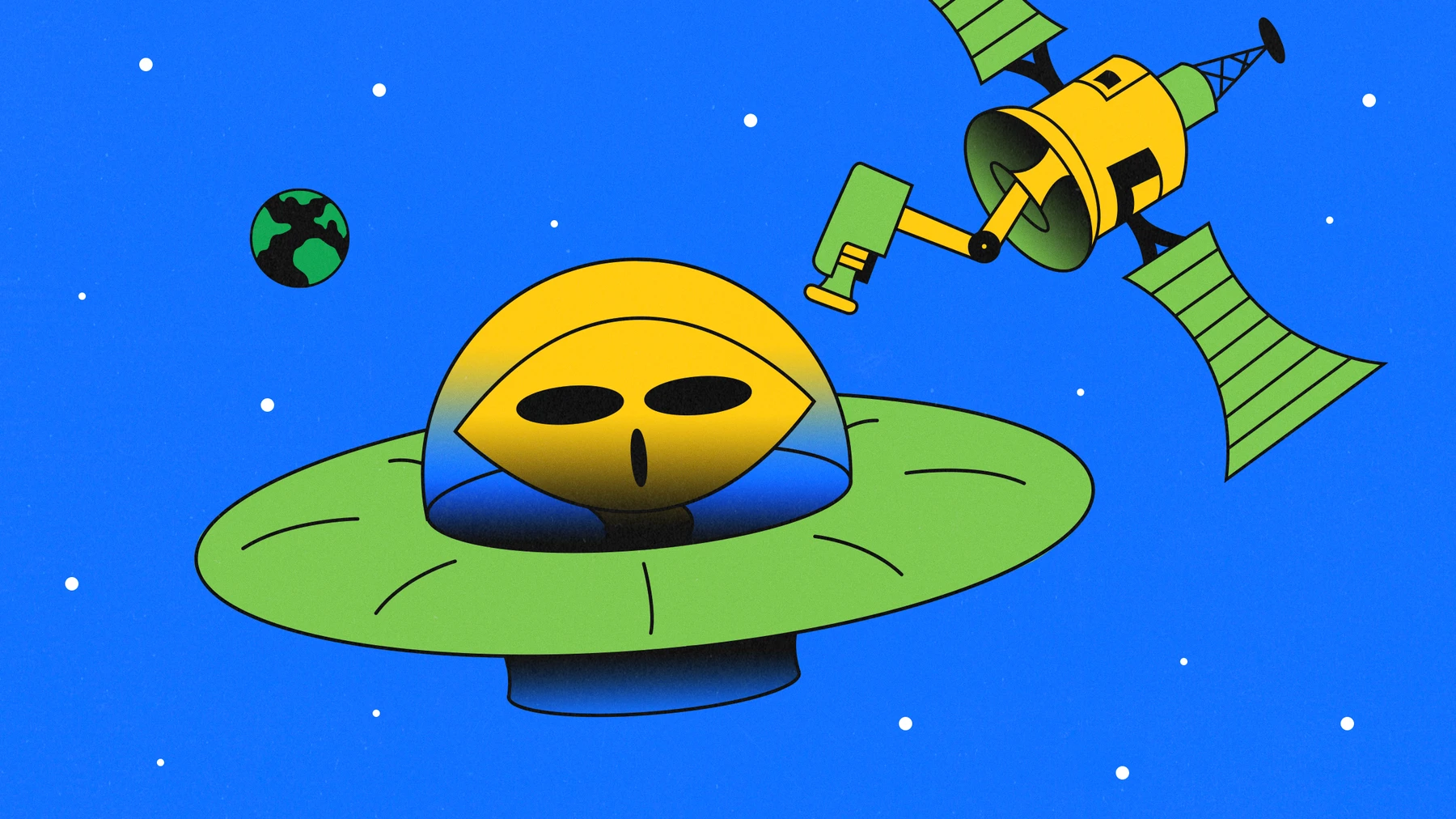Nearly 4,000 light-years away, there’s a star called VY Canis Majoris. It is, in a word, huge. It’s 270,000 times as bright as the Sun, and if you plunked it down in the middle of our solar system, it would burn Saturn.
VY Canis Majoris is a hyper giant star. And perhaps it is no surprise that there’s a tech startup humbly eponymizing it: Hypergiant Industries, a company that aims, its website explains, to be “the guiding light that solves humanity’s most challenging problems.”
The company uses AI in a few different industries: It’s developed the Disaster Mapping System, geospatial software that picks out the hardest-hit buildings after a natural disaster using satellite and drone images, available open-source through an AI platform called Modzy. It’s also created a prototype augmented reality helmet which can detect and classify objects, and offers night vision and thermal imaging in addition to regular seeing. And it’s built a fridge-sized bioreactor prototype that uses AI to regulate things like air flow, light, temperature, and pH so that algae can sequester carbon dioxide and turn it into materials for biofuel. Oh, and it’s built kinda boring workflow efficiency software for companies like GE and Shell, plus a “Virtual Bartender” for TGI Fridays.
Hypergiant was founded just two years ago, in 2018, but the company has already worked with the likes of Booz Allen Hamilton, Shell, NASA, the National Reconnaissance Office, and the Department of Homeland Security. The company spun up so quickly in part because it didn’t just build from scratch. It fused already-extant elements: buying image-analysis companies, investing in AI developers, and scooping up space technology, in the service of delivering on its slogan: “Tomorrowing today.”
That all sounds pretty legit: Serious government agencies, serious firms, serious fortune, and Fortune 500. And that clout is probably part of why Hypergiant’s R&D division can, without risking too much blowback, now take a risk on something farther-out: UFO research. This may actually be more grounded, and profitable, than it sounds.
Hypergiant was founded by CEO Ben Lamm, a serial entrepreneur who sold his previous companies to big names like Zynga and Accenture. This company, though, he intends to hang on to.
Once Lamm decided he wanted to start Hypergiant, he said in an interview, he and his team started brainstorming where AI could still make a big difference. They settled on three main areas: infrastructure, like supply chains and logistics; defense; and space.
On the list of those projects on the company’s website, though, the new UFO endeavor isn’t listed. The company’s website does list some projects as “redacted,” however.
But Lamm does talk about UFOs, though he calls them UAP: Unidentified Aerial Phenomena. It’s the term insiders and the government have introduced to ditch the baggage that the decades-old “UFO” has amassed. If you look at the intersections Hypergiant’s three main interests, says Lamm, “UAPs are the X at the cross center.”
He’s interested in finding out whether those UAP come from here, or out there. “The question of whether we’re alone in the universe is kind of like ‘Is the Earth flat?’” he says (“no” being the answer to both, in his mind).
The US government has recently vocalized its interest in UFOs: the Navy has crafted new guidelines for soldiers to report sightings; Congresspeople have gotten classified briefings; officials speak of strange stuff in the sky as an imposing national-security threat.
Notably, there’s no evidence that directly supports the interpretation that UFOs are of extraterrestrial origin. In fact, signs point in a different direction: the Navy has said that UAP sightings are on the rise “consistent with the wide proliferation and availability of inexpensive unmanned aerial systems,” which are just cheap drones. Military definitions of “UAP” include objects that are simply unauthorized, not necessarily unidentified.
Lamm accepts that the phenomena might just be earthly technology, and he wants Hypergiant to help find whatever truth is out there.
“If this is a brilliant lady and guy who build insane technology in a garage in Iowa, we should know about that,” he says. “Regardless of what the UAP is and whether it has a terrestrial origin or not, I think it’s important for people’s safety.”
Hypergiant’s research trajectory homes in on exactly what UAP investigators have never nabbed: hard data collected in a systematic way. In this case, data largely from Earth-watching satellites.
The company plans to scrutinize that data with software it’s developing called CONTACT: Contextually Organized Non Terrestrial Active Capture Tool. Although it’s still in early stages, it will, the company hopes, burrito together adapted versions of Hypergiant’s existing tools, like the Disaster Mapping System, and new ones, to parse orbital and aerial images in search of Anomalies.
In its future final form, CONTACT will analyze 3-dimensional satellite data. Or ”volumetric” information, that reveals not just where a craft is in terms of its latitude, longitude, and altitude. CONTACT will spot the differences between satellite images and throw up a flag if, say, a mothership flies into a field of view at noon when it wasn’t there yesterday, and then determine whether it’s actually just a jet at a weird angle.
For that task, the team is developing a neural network that can recognize known aircraft. “This is xyz helicopter,” says Lamm. “This is xyz Raptor. This is a Boeing 737.” Those go in the digital trash.
To help train these aircraft-spotting algorithms, Hypergiant is creating a siphon that sucks up public information about creepy sky sightings that people think are unidentified and tags them with locations and times. The software will then dive into satellite and drone archives, gather images of the right regions and hours, and use computer vision to find fliers. After comparing whatever it finds against known airline flight paths, and screening out all the Boeing’s, the researchers will use what’s left as training data, to help AI identify UAP in future observations.
Hypergiant positions CONTACT as a way to investigate cosmic mysteries: to toss out terrestrial knowns in search of possible extraterrestrial unknowns. But the tool would be equally adept at identifying terrestrial unknowns: experimental drones, and advanced military aircraft tests, for example. Because of this, Lamm believes that CONTACT would be of keen interest to officials with extremely earthly concerns. “It’s highly valuable to big defense contractors, the Air Force, radar operators,” says Lamm.
If things go well, which they often don’t in space, Hypergiant engineers will start gathering their own data. On a rocket scheduled to launch in March, Hypergiant will send up its first instrument that can take 3-D observations, in the form of a payload piggybacked on a larger satellite. Data should start to rain down in April or May.
Assuming that works, the first satellite of Lamm’s 30+ orbiter constellation will go up in the fall, on the Cygnus NG-14 and SpaceX SpX-21 missions. And then, presumably, the other 29 or so. And then, perhaps, the startup will data that will illuminate what we talk about when we talk about UAP, UFOs, or whatever acronyms someone comes up with later. To see whether or not all of that happens, we’ll have to wait till today becomes tomorrow.
Please remember we all have different opinions, Think Before You Speak or Write Something that is cruel to Others. After all, We are only Humans. Wishing you clear skies and wide eyes. To share your experiences or just leave a comment there is a area below. Read or listen.
We are the change the world has been waiting for!
Have you witnessed an unidentified flying object?
You are not alone. Whether you think UFOs are black projects, extraterrestrial craft, something else altogether, or just don’t know, again, you are not alone!
Unconditional love. The road we all get to walk. Unconditional love is like the sun.
WE ARE THE DISCLOSURE !~ WE HAVE NEVER BEEN ALONE
Love and Regards,
Thank You,
Nancy Thames
Source:Sarah Scoles



